Mac's Believe It or Not!
by John McDougald
Reprinted from "Crown Jewels of the Wire", January 2003, page 7
Well, Mrs. Mac is now officially retired from editing Crown Jewels of the
Wire. So, what is she doing? Cleaning house, washing clothes, preparing gourmet
meals? No, she has spent better than six weeks on the road photographing
insulators for a new reference book we plan to co-author for release next year.
Every photograph will be in color...no more black and white. As you can imagine,
she has seen some pretty spectacular collections and there are more to
photograph in the next couple of months.
During one of her photographic jaunts, 'I was forwarded an email from Mrs.
Mac which she had been sent from a magazine subscriber. He had received an email
from "Mr. Non-insulator Collector" who had purchased a "strange
insulator" at an auction in Indiana and he was asking that we contact him
about his recent purchase. Being a bottle collector and well aware of
interesting pieces of glass, the embossing on the glass piece started "Mr.
Non-insulator Collector's" search to find out more about what he had
bought. Photos were exchanged through email and it was evident that this piece
needed to be seen in person.
At the first opportunity, Mrs. Mac and I arranged a time to meet at a midway
point between our home in Chicago and his home in Indiana. Armed with her laptop
computer loaded with photos she had been taking, Mrs. Mac and I set up for
business in a booth at a local Arby's restaurant. Out of "Mr. Non-insulator
Collector's" Priority Mail box emerged a well-wrapped insulator.
Believe it or Not! There was a threadless insulator that looked like the top
of a CD 141.8 Buzby. "Mr. Non-insulator Collector" had looked for
information on the patent and discovered that the insulator he purchased was
what he thought to be the original Buzby design. I would have to concur with his
theory.
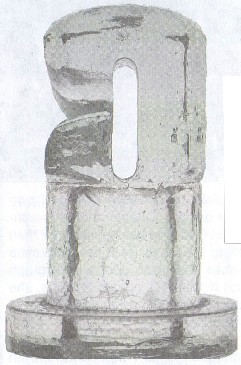
Side view of Buzby Prototype in light aqua.
Overall Height - 4"
Diameter
at base flange - 3"
Flange is 1/2" wider than neck. |
Neck Diameter - 2"
Thickness of neck glass - 3/8"
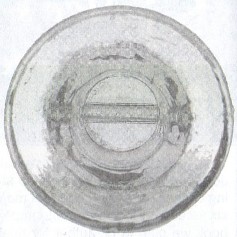
Looking from base up into the pinhole.
Pinhole tapers from pinhole entrance
diameter of 1.25" to 1 " in diameter at top of pinhole. |
As of this writing, I am aware of only five Buzby insulators that are in
collections. And, Mrs. Mac had seen every one of them in her journeys. So,
Believe it or Not!, we had photos for comparison right on our laptop computer.
The May 8, 1890 patent (No. 427,296) granted to Joseph F. Buzby of Royer's
Ford, Pennsylvania was one of the first trendy "no-tie" insulator
designs that were patented between the early 1890's and the 1920's. As indicated
in the patent drawings, there was "no
model" at the time of filing.
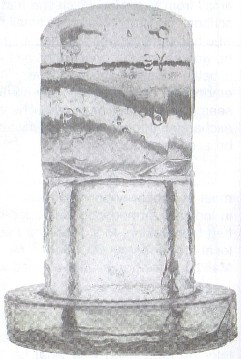
Embossing on the face of the Buzby prototype.
Beveled crown is identical to threaded CD 141.8.
And, there is absolutely no mention of internal threading as part of the
design of the insulator in the patent. What I believe "Mr. Non-insulator
Collector" has found is the insulator prototype made to the specifications
of the insulator patent. (See Fig. 2 of the patent drawing.)
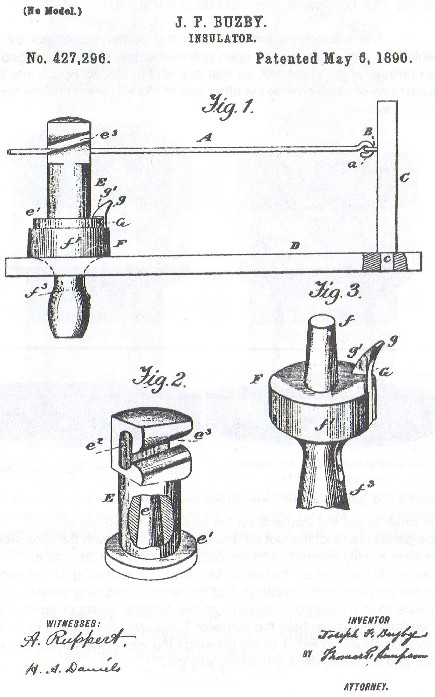
"E represents my insulator, which, has the central tapering vertical hole e
in its lower end to fit over an upwardly-tapering projection f on the
insulator-stand F and a flange e', which bears on a corresponding flange f' of
the stand, the two flanges being clamped together by a spring-latch G, made fast
on the side of the stand.
The insulator is provided with the perpendicular slot e2, in which the wire
rests, and an open communicating slot e3, arranged at an oblique angle to slot
e2, so that one end of slot e3 opens into the upper end of slot e2, while the
other end of slot e3 opens into the lower end of slot e2.
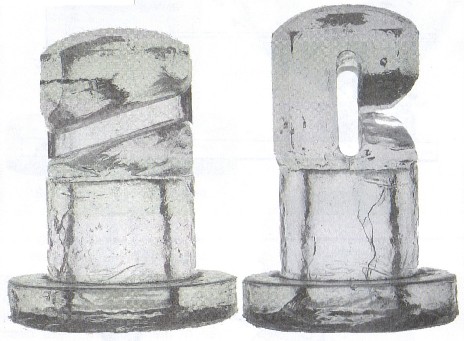 |
|
Buzby prototype's front side showing angled slot. Slot is identical to
threaded CD 141.8. |
Fourth side of the Buzby prototype. |
In order to put the insulator on the wire, it is turned out of perpendicular
until the slot e3 is in the same plane with the wire, which is then readily
entered. The insulator is then turned back to a perpendicular and so locked to
its stand. The head g of the spring catch projects over the flange f' of the
stand, and being inclined at g', yields. to the insulator, flange e' as the
latter is pressed down, then overlaps it so as to hold the insulator E securely
to its stand F. In the position shown in Fig. 1 to the drawings the wire A lies
across the slot e3, and therefore cannot possibly escape."
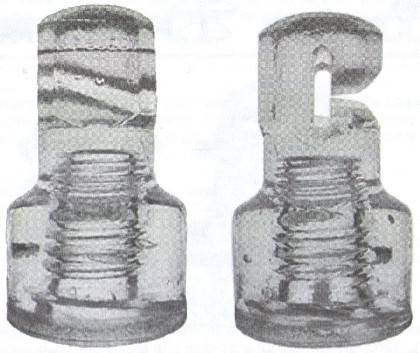 |
CD 141.8 Buzby
Front View |
CD 141.8 Buzby
Side View |
This find just may be the one and only prototype of a known rare patent that
has ever been located. There have been patent models, but this patent had no
model. And, it is also known that not all insulators that have been patented
(successful or unsuccessful) look like their patent drawings. Up until this
point, it has always been thought that the CD 141.8 Buzby was made as a threaded
insulator with a crown configuration that matched the 1890 patent. Owing to that
fact that only five units are known to this author, I would say that it was not
a successful design. Now, we all know the rarity of the threaded pieces, what
kind of value would one place on a prototype? Believe It Or Not! "Mr.
Non-insulator Collector" wants to find out!
| 